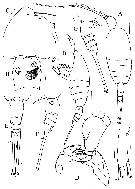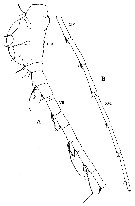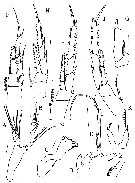|
|
 |
|
Calanoida ( Order ) |
|
|
|
Hyperbionychidae ( Family ) |
|
|
|
Lamiantennula ( Genus ) |
|
|
| |
Lamiantennula longifurca Markhaseva & Schulz, 2006 (F) | |
| | | | | | | Ref.: | | | Markhaseva & Schulz, 2006 b (p.204, figs.F, Rem.: p.209); Bradford-Grieve, 2010 (p.2171: u>Rem.) |  issued from E.L. Markhaseva & K. Schulz in Arthropodia Selecta, 2006, 15 (3). [p.205, Fig.1]. Female (from 64°02'S, 39°07'W): A-B, habitus (dorsal and lateral, respectively); C-D, anterior part of cephalosome (lateral and ventral, respectively); E, urosome (dorsal; upper arrow indicates proximal vestigial lateral seta, lower arrow indicates scar from broken distal lateral seta); F-G, idem (left and right lateral, respectively); H, genital double-somite (ventral); I, distal part of right caudal ramus (dorsal; arrow indicates distal lateral seta broken, only scar is observed). Scale bars: 0.5 mm (A-B); 0.1 mm (C-I). Nota : Prosome 1.4 times as long as urosome. Rostrum with 2 long and slender filaments. Cephalosome and pediger 1 separate, 4th and 5th fused. Genital double-somite longer than urosomites 2-4, slightly asymmetrical in dorsal view ; genital structures asymmetrical. Anal somite shortest. Caudal rami symmetrical, 1.2 times as long as urosomites 1-4, with 7 setae (1 small proximal lateral seta, 1 distal lateral seta broken (only scar), 4 large terminal setae and 1 small dorsal seta).
|
 issued from E.L. Markhaseva & K. Schulz in Arthropodia Selecta, 2006, 15 (3). [p.206, Fig.2]. Female: A, left A1, segments 1-11 (ancestral segments I-III, IV-XIII); B, idem, segments 12-17 (ancestral segments XIV-XIX, segment 18 broken. Scale bar: 0.1 mm. Nota: Segment 1 is a complex of ancestral segments I-III.
|
 issued from E.L. Markhaseva & K. Schulz in Arthropodia Selecta, 2006, 15 (3). [p.207, Fig.3]. Female: A, A2; B, Mx1 (setation of coxal endite, endopod and exopod omitted, arrow indicates epipodite); C, Mx1 (coxal endite, endopod and exopod); D, Mx2 (armature of basis and endopod omitted); E, Mx2 (basis and terminal part of limb with endite and endopod); F, Mxp (inner lamella of endopodal segments 5 and 6 stippled). Scale bars: 0.1 mm. Nota : A2 : coxa without seta ; basis with 2 unequal setae ; exopod 9-segmentd as long as endopod, with 0, 0, 1, 1, 1, 1, 1, 0 and 3 setae ; endopod segment 1 with 2 subdistal setae, segment 2 with 4 + 6 setae. Mx1 : praecoxal arthrite larger than rest of appendage, with 16 elements (3 slender setae plus 7 robust spinulose spines, 4 posterior and 2 anterior setae ; coxal endite with 3 setae ; proximal basal and distal endites reduced, unarmed ; endopod long with 3 distal setae ; exopod with 2 distal setae ; coxal epipodite without setae. Mx2 : proximal praecoxal endite with 5 setae, distal with 1 seta ; proximal coxal endite with 2 setae, distal with 3 setae ; basis with angula router crest ; proximal basal endite with 4 setae (1 very small) ; terminal part of Mx2 (endopod ?) proximally with 4 setal elements on 1st large endite (2 thick and spinulose spines, 2 thin short setae) and distally with 6 long and 1 short strong, spinulose setae.
|
 issued from E.L. Markhaseva & K. Schulz in Arthropodia Selecta, 2006, 15 (3). [p.208, Fig.4]. Female: A, right Md (mandibular palp); B, left Md (exopod); C, left Md (gnathobase); D, left Md (teeth of cutting edge); E, left Md (terminal setae of endopod segment 2); F, P1 (anterior); G, P1 (basis with poorly scleritized posterior spine and exopod segment 1; lateral view); H, P2 (posterior); I, P3 (posterior); J, P4 (posterior); K, P5. Scale bars: 0.1 mm. Nota : P1 : coxa with medial seta ; basis with distomedial seta strongly curved and with poorly sclerotized spine on posterior face . P5 symmetrical, uniramous ; coxa and basis fused, with 1 distolateral seta ; exopod 1-segmented, incompletely separate from basis, with 2 terminal setae (1 long, 1 short and spine-like).
| | | | | NZ: | 1 | | |
|
Distribution map of Lamiantennula longifurca by geographical zones
|
| | | | | | | Loc: | | | Antarct. (Weddell Sea) | | | | N: | 1 | | | | Lg.: | | | (970) F: 3,7; {F: 3,70} | | | | Rem.: | hyperbenthic; abyssal (4748-4743 m).
For Markhaseva & Schulz (2006 b, p.209) this species shares unusually long caudal rami with the monotypical arietelloidean family Lucicuttidae Sars, 1902. It differs in main diagnostic characters typical of Lucicutia Giesbrecht, 1898: basis of P1 lacking tubular process itemized in the diqgnosis of Lucicutia by Hulsemann (1966, p.703), and, correspondingly, has no large pore with inner seta originating on the outer, posterior wall of pore as described by Markhaseva & Ferrari (2005, p.1094); the species is also distinguished from Lucicutia in shape and setation of oral parts and a short uniramous P5. The new genus appears related to a group of three arietelloidean families (Soh, p.208, 227), viz. Hyperbionychidae, Nullosetigeridae and Arietellidae with which it shares: 1- the reduced number of setae on A2 endopod segment 2: 2- complete loss of setae on the basis of mandibular palp; 3- reduced setation on mandibular endopod segment 2; 4- the reduced number of setae on the exopod of Mx1.
Despite the significant differences between Hyperbyonix and Lamiantennula, until the male will be described the new genus is preliminary placed in the family Hyperbionychidae as the probable most related arietelloidean family. | | | Last update : 18/03/2015 | |
|
|
 Any use of this site for a publication will be mentioned with the following reference : Any use of this site for a publication will be mentioned with the following reference :
Razouls C., Desreumaux N., Kouwenberg J. and de Bovée F., 2005-2025. - Biodiversity of Marine Planktonic Copepods (morphology, geographical distribution and biological data). Sorbonne University, CNRS. Available at http://copepodes.obs-banyuls.fr/en [Accessed October 22, 2025] © copyright 2005-2025 Sorbonne University, CNRS
|
|
 |
 |







